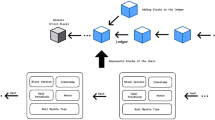Abstract
Blockchain is the new disruptive technology which is gaining momentum in several domains of real-world applications such as Bitcoin—the most well-known example, and primarily in the financial sector. Distributed ledger system which is the main feature of blockchain technology protected across harmful updates using cryptographic techniques, e.g. hashing and digital signatures, is spread over the network so that no one is the owner of the ledger. This poses a significant challenge in the areas of performance, security, and privacy using this emerging technology. We propose an algorithm to provide a secure mechanism for performing transactions on the Blockchain network by adopting quantum digital signatures (QDS) and quantum teleportation phenomenon of quantum computing. The proposed algorithm uses key pairs to generate private keys and corresponding public keys; the quantum digital signatures are used to sign the message which are then distributed over the blockchain network using the teleportation phenomenon. The security of the keys is dependent on the fundamental principles of quantum mechanics that doesn’t allow forging. The Einstein–Podolsky–Rosen (EPR) pair of particles is used to communicate the quantum information via a quantum channel for teleportation, which is generated by operating Bell measurements with corresponding EPR pairs. The original state of the particle (sender) is destroyed once the information is transported to the other particle (receiver) and the QDS scheme also validates the qubits received. The twofold validation process thereby provides high-level security in the transactions.





Similar content being viewed by others
References
Nakamoto S (2008) Bitcoin: a peer-to-peer electronic cash system (2008)
Tschorsch F, Scheuermann B (2016) Bitcoin and beyond: a technical survey on decentralized digital currencies. IEEE Commun Surv Tutor 18(3):2084–2123
Chaum D (1983) Blind signatures for untraceable payments. Advances in cryptology. Springer, Boston
Wan J et al (2019) A blockchain-based solution for enhancing security and privacy in smart factory. IEEE Trans Ind Inf 15:3652–3660
Qian J, Tiwari P, Gochhayat SP, Pandey HM (2020) A noble double dictionary based ECG compression technique for IoTH. IEEE Intern Things J. https://doi.org/10.1109/jiot.2020.2974678
Kumar S, Tiwari P, Zymbler M (2019) Internet of Things is a revolutionary approach for future technology enhancement: a review. J Big Data 6(1):111
Bebortta S, Senapati D, Rajput NK, Singh AK, Rathi VK, Pandey HM, Jaiswal AK, Qian J, Tiwari P (2020) Evidence of power-law behavior in cognitive IoT applications. Neural Comput Appl. https://doi.org/10.1007/s00521-020-04705-0
Gochhayat SP, Kaliyar P, Conti M, Tiwari P, Prasath VBS, Gupta D, Khanna A (2019) LISA: lightweight context-aware IoT service architecture. J Clean Prod 212:1345–1356
Peters G, Panayi E, Chapelle A (2015) Trends in cryptocurrencies and blockchain technologies: a monetary theory and regulation perspective. J Financ Perspect 3(3)
Courtois NT, Bahack L (2014) On subversive miner strategies and block withholding attack in bitcoin digital currency. arXiv preprint arXiv:1402.1718
Chen G et al (2006) Quantum computing devices: principles, designs, and analysis. Chapman and Hall/CRC, Boca Raton
Riebe M et al (2004) Deterministic quantum teleportation with atoms. Nature 429(6993):734
Barrett MD et al (2004) Deterministic quantum teleportation of atomic qubits. Nature 429(6993):737
Bennett CH et al (1993) Teleporting an unknown quantum state via dual classical and Einstein–Podolsky–Rosen channels. Phys Rev Lett 70(13):1895
Deutsch D, Hayden P (2000) Information flow in entangled quantum systems. Proc R Soc Lond Ser A: Math Phys Eng Sci 456(1999):1759–1774
Gottesman D, Chuang I (2001) Quantum digital signatures. arXiv preprint arXiv:quant-ph/0105032v2
Nielsen MA, Chuang I (2002) Quantum computation and quantum information. Am J Phys 70:558–559
Brown J (2001) Quest for the quantum computer. Simon and Schuster, New York
Wehner S, Elkouss D, Hanson R (2018) Quantum internet: a vision for the road ahead. Science. https://doi.org/10.1126/science.aam9288
Author information
Authors and Affiliations
Corresponding authors
Additional information
Publisher's Note
Springer Nature remains neutral with regard to jurisdictional claims in published maps and institutional affiliations.
Rights and permissions
About this article
Cite this article
Singh, S., Rajput, N.K., Rathi, V.K. et al. Securing Blockchain Transactions Using Quantum Teleportation and Quantum Digital Signature. Neural Process Lett 55, 3827–3842 (2023). https://doi.org/10.1007/s11063-020-10272-1
Published:
Issue Date:
DOI: https://doi.org/10.1007/s11063-020-10272-1




